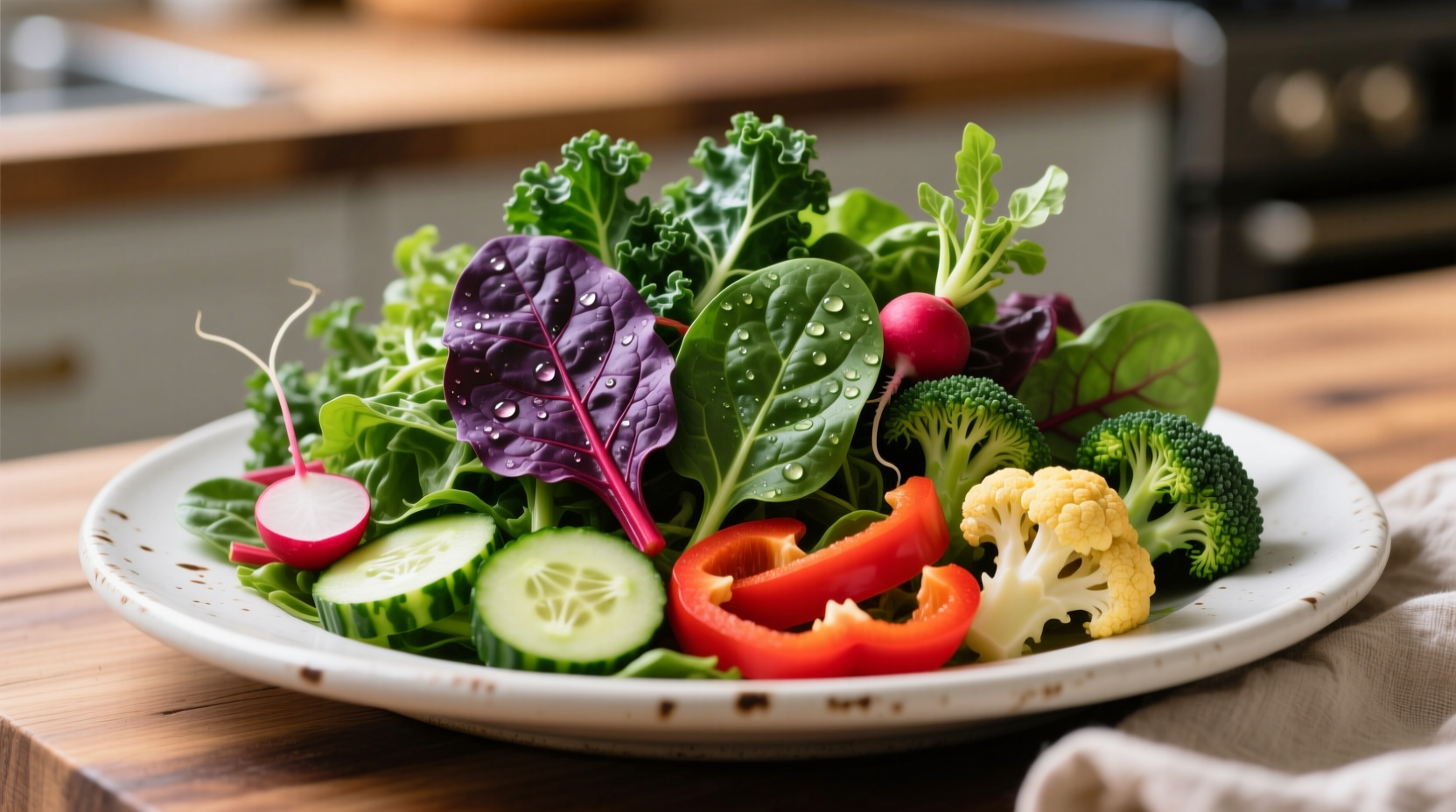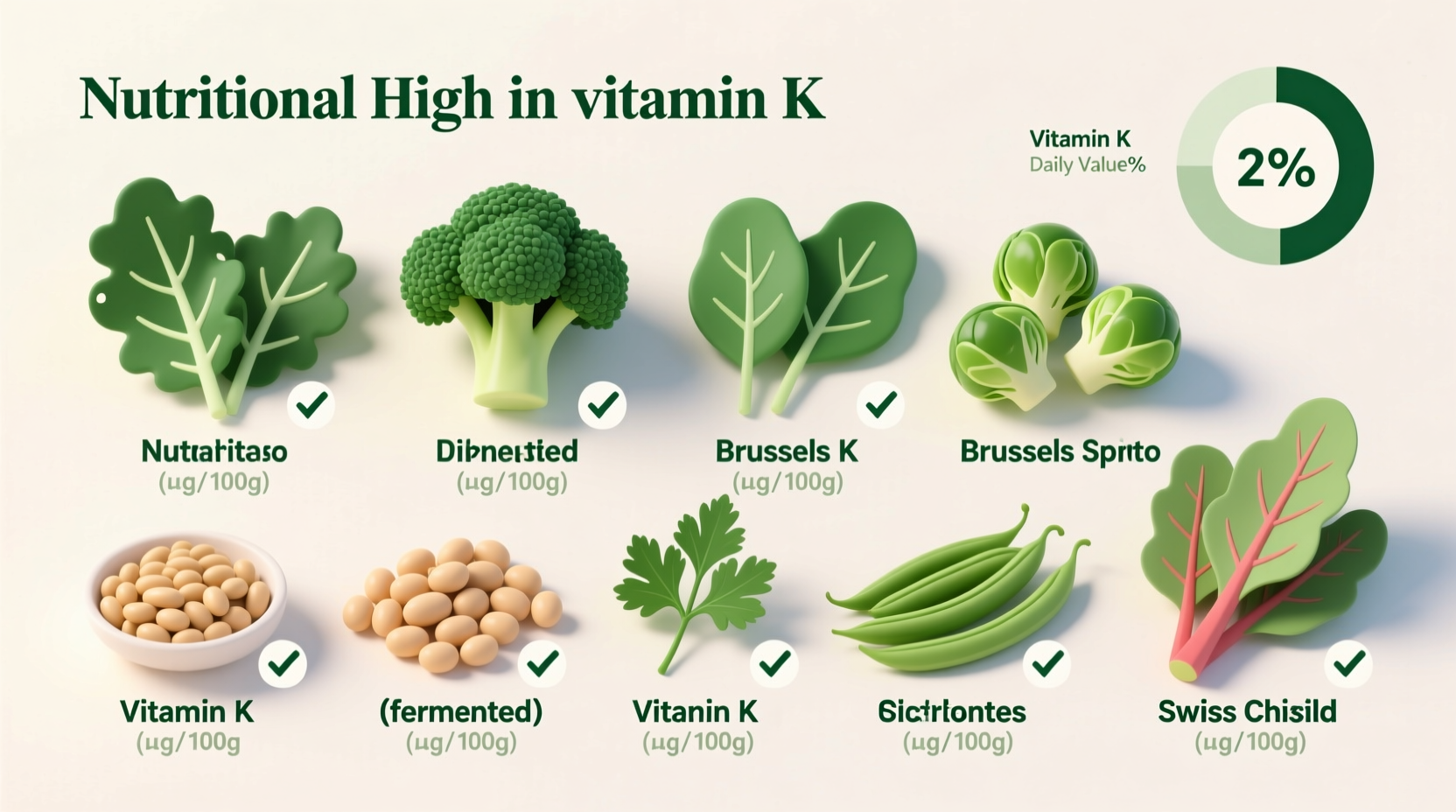Leafy green vegetables contain the highest natural concentrations of vitamin K1, with kale leading at 1,062 mcg per cooked cup. Fermented foods like natto provide exceptional vitamin K2 amounts, delivering 850 mcg per 2-ounce serving. Understanding these food sources helps maintain proper blood clotting function and supports bone density.
Why Vitamin K Matters for Your Health
Vitamin K serves two critical biological functions: enabling blood coagulation and activating osteocalcin, the protein that binds calcium to bones. Without sufficient vitamin K, your body cannot produce prothrombin, essential for stopping bleeding. Recent research from the National Institutes of Health shows adults need 90-120 mcg daily, but many fall short of this requirement.
USDA Verified Vitamin K Content in Common Foods
| Food | Portion | Vitamin K (mcg) | % Daily Value |
|---|---|---|---|
| Kale, cooked | 1 cup | 1,062 | 885% |
| Spinach, cooked | 1 cup | 889 | 741% |
| Natto | 2 oz | 850 | 708% |
| Broccoli, cooked | 1 cup | 220 | 183% |
| Brussels sprouts | 1 cup | 219 | 182% |
Source: USDA FoodData Central (accessed September 2025)
Vitamin K1 vs K2: Understanding the Difference
Most people don't realize there are two primary forms of vitamin K with different food sources and biological impacts. Vitamin K1 (phylloquinone) comes predominantly from plant sources, particularly leafy greens. Vitamin K2 (menaquinone) appears mainly in animal products and fermented foods. Research published in Nutrition Reviews demonstrates that K2 remains active in your bloodstream up to 10 times longer than K1, making it particularly valuable for bone health.

Top Vitamin K Food Categories
Leafy Green Powerhouses
Dark leafy greens dominate the vitamin K landscape. Just one cup of cooked Swiss chard delivers 573 mcg, while collard greens provide 530 mcg per cooked cup. Even raw greens pack a punch - a single cup of raw spinach contains 145 mcg. The vitamin K content increases significantly when greens are cooked, as the process breaks down cell walls and concentrates nutrients.
Fermented Foods for Vitamin K2
Natto, the fermented soybean product popular in Japan, contains extraordinary vitamin K2 levels. Other fermented options include certain cheeses like Gouda (21% DV per ounce) and hard cheeses. The fermentation process activates bacteria that convert K1 to the more bioavailable K2 form. A 2023 study from the American Journal of Clinical Nutrition confirmed that regular natto consumption significantly improves vitamin K status compared to leafy greens alone.
Cruciferous Vegetables
Beyond leafy greens, cruciferous vegetables offer substantial vitamin K. One cup of cooked broccoli delivers 220 mcg, while Brussels sprouts provide 219 mcg per cup. These vegetables also contain sulforaphane, which works synergistically with vitamin K for cardiovascular protection. Steaming preserves more vitamin K than boiling, which can leach nutrients into cooking water.
Practical Incorporation Strategies
Maximize vitamin K absorption by pairing these foods with healthy fats. Vitamin K is fat-soluble, so adding olive oil, avocado, or nuts to your leafy green salads increases absorption by up to 150% according to research from the Journal of Nutrition. Try these simple approaches:
- Add spinach to smoothies (1 cup raw = 145 mcg)
- Replace lettuce with kale in sandwiches
- Include broccoli in omelets (1 cup = 220 mcg)
- Enjoy fermented foods like natto 2-3 times weekly
- Use herbs like parsley (1/4 cup = 246 mcg) generously in cooking
Important Considerations for Medication Users
If you take blood thinners like warfarin, maintaining consistent vitamin K intake is crucial. Sudden increases or decreases can interfere with medication effectiveness. The American Heart Association recommends working with your healthcare provider to establish a stable daily intake rather than avoiding vitamin K-rich foods completely. Many patients successfully manage both their medication and nutrition by keeping vitamin K consumption steady day-to-day.
Vitamin K Intake Guidelines for Different Populations
The National Academies of Sciences, Engineering, and Medicine established these daily requirements:
- Adult men: 120 mcg
- Adult women: 90 mcg
- Pregnant/breastfeeding women: 90 mcg
- Children (ages 4-8): 55 mcg
These values represent adequate intake levels based on observed healthy populations. Individual needs may vary based on health conditions and medication use. Source: National Institutes of Health Office of Dietary Supplements
Avoiding Common Vitamin K Mistakes
Many people make these critical errors when trying to increase vitamin K intake:
- Overcooking greens - Boiling leaches vitamin K into water. Steam instead to preserve nutrients.
- Ignoring fat pairing - Consuming vitamin K foods without healthy fats reduces absorption.
- Inconsistent intake - Fluctuating amounts can be problematic for those on blood thinners.
- Misunderstanding K1 vs K2 - Not recognizing that different forms have different benefits.
For optimal results, incorporate a variety of vitamin K sources throughout your week while maintaining consistent daily amounts if you're on medication.
How quickly does vitamin K affect blood clotting?
Vitamin K begins influencing blood clotting factors within 6-12 hours of consumption, with maximum effect seen after 24-48 hours. This is why consistency in vitamin K intake matters for those taking blood thinners like warfarin.
Can you get too much vitamin K from food?
Natural vitamin K from foods rarely causes toxicity. The Institute of Medicine hasn't established an upper limit because no adverse effects have been observed from high food intake. However, extremely high supplemental doses may cause issues.
Which form of vitamin K is better for bone health?
Vitamin K2 (particularly the MK-7 form found in natto) shows stronger evidence for bone health benefits than K1. Research indicates K2 remains active in the bloodstream longer and activates osteocalcin more effectively for calcium binding to bones.
Do cooking methods affect vitamin K content?
Yes, cooking methods impact vitamin K levels. Steaming preserves more vitamin K than boiling, which can leach nutrients into water. Sautéing with healthy fats like olive oil actually enhances absorption. Raw consumption provides vitamin K but with lower absorption without accompanying fats.











 浙公网安备
33010002000092号
浙公网安备
33010002000092号 浙B2-20120091-4
浙B2-20120091-4